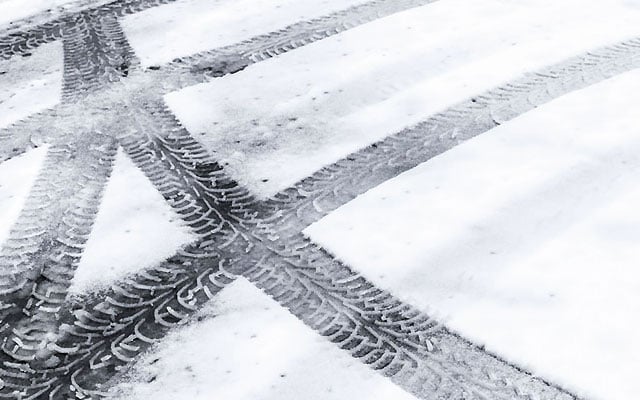In parts of Europe it’s common, or even a legal requirement, for drivers to keep 2 sets of wheels and tyres – one for summer and another for winter.
- Normal 'summer' tyres stiffen up when the temperature drops.
- Winter tyres use a type of rubber (with a high silica content) and a tread pattern designed to stay flexible in low temperatures (below 7C).
- They give better braking and handling performance on snow and ice as well as on wet roads in cold conditions.
- Winter tyres are marked with a symbol showing a snowflake or snow-topped mountains.
Winter tyres aren’t really suited to all-year-round use. Summer tyres perform better when temperatures rise and the road’s dry, so you'll need 2 sets of tyres if you're going to choose specialist tyres for driving in winter.

Why don't we have to use winter tyres?
There are good practical and economic reasons why winter tyres aren't compulsory here:
- Many regions only rarely experience the sort of weather conditions that would justify the extra cost and hassle.
- Many drivers choose not to use the car when snow or ice are around.
- The overall cost would be too high – roughly £15 billion nationally for wheels, tyres, storage and fitting costs.
Who should buy winter tyres?
Winter tyres make sense if you live in a remote area of the country where conditions are likely to be worse for longer.
Elsewhere it may be harder to justify the cost, though this has to be a personal decision depending on:
- The risk of bad weather
- Your confidence when driving, and
- How much you have to drive when there's snow and ice around.
Do I need to get new wheels?
You can keep the same wheels and get a tyre fitter to swap your tyres twice a year – summer to winter in the autumn and winter to summer in the spring – or you can buy a second set of wheels.
Some suppliers sell winter tyres that are pre-fitted to steel wheels:
- Steel wheels are cheaper than alloys.
- You may have to switch to a different type of wheel nut or bolt – check with the supplier or car manufacturer.
Should I get 2 or 4 winter tyres?
If you're going to switch you'll have to buy 4 winter tyres. Fitting only one pair will upset the stability of your car.
All season tyres
- All season tyres use a similar rubber compound to winter tyres but have a tread pattern somewhere between a normal summer tyre and an out-and-out winter tyre.
- They're a bit of a compromise but should work better on wintry roads than a summer tyre and avoid the cost and hassle of swapping tyres twice a year.
Do I need snow chains?
Winter wheels and tyres are quite an expensive option so you might want to think about carrying snow chains for emergencies instead. Bear in mind though:
- You can only use chains where the road surface is protected from damage by a layer of compacted snow or ice.
- Snow chains can be awkward to fit and remove in the cold with gloved hands and wheel arches packed with snow.
More advice on tyres:
Insurance questions
There should be no need to tell your insurer if you fit winter tyres to your original wheels, even though the speed index might be lower.
The tyre speed index is still likely to exceed national speed and isn't checked as part of the car MOT test.
If you use a second set of wheels for your winter tyres you shouldn't need to tell your insurer as long as the wheels are of the correct specification:
- Wheel diameter, width and offset must all meet the vehicle manufacturer's spec.
- Check your handbook for wheel and tyre sizes suitable for your car.
We've heard stories of insurers raising premiums or remarkably even refusing cover if winter tyres are fitted but this shouldn't be the case any more.
The Association of British Insurers (ABI) published a commitment setting out the position of some named insurers on premiums and winter tyres.
Check the ABI's list as some insurers require you to tell them you've fitted winter tyres even though your premium or cover won't change.
Insurers' commitment and list of insurers
Tread depth and pressure
Whether you've got summer or winter tyres fitted, they must have enough tyre tread – at least 3mm is recommended for winter, and certainly no less than 2mm.
Don't be tempted to try dropping your tyre pressure when there's snow and ice about – it doesn't help with grip and can affect your car's handling.
